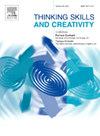Validating the Second Language Teaching for Creativity Scale (L2TCS) and applying it to identify Chinese college L2 teachers’ latent profiles
IF 3.7
2区 教育学
Q1 Social Sciences
引用次数: 0
Abstract
Given the role of creativity in personal growth and societal advancement, fostering creativity among students, specifically through Teaching for Creativity (TfC), is crucial in educational settings. The second language (L2) classroom stands out as an ideal environment for nurturing creativity due to its exposure to diverse cultural contexts. However, there exists no specific scale designed to assess TfC in the L2 context. To bridge this gap, Study 1 focuses on developing the Second Language Teaching for Creativity Scale (L2TCS) and evaluating its psychometric properties among Chinese college L2 teachers. Our scale development process involved two separate samples. In Sample 1 (n = 362), exploratory factor analysis (EFA) revealed an 18-item L2TCS, comprising three factors: Creativity Ability (CA), Creativity Value (CV), and Creativity Belief (CB), explaining 77.06 % of the total variance. In Sample 2 (n = 328), confirmatory factor analysis (CFA) confirmed the scale's adequate model fit. Moreover, the L2TCS showed satisfactory convergent, discriminant, and criterion validity, and reliability. These findings affirm the L2TCS as an effective tool for evaluating L2 teachers’ TfC. Study 2 utilized this scale to identify latent profiles of Chinese college L2 teachers’ TfC (n = 691) using Latent Profile Analysis (LPA). Four distinct profiles emerged: high CA-high CV-high CB (C1: 29.4 %), moderate CA-high CV-low CB (C2: 5.2 %), moderate CA-moderate CV-moderate CB (C3: 19.2 %), and moderate CA-high CV-moderate CB (C4: 48.2 %). This study also discusses the theoretical and pedagogical implications and suggests directions for future research.
第二语言教学创造力量表(L2TCS)的验证及其在中国大学第二语言教师潜在特征识别中的应用
鉴于创造力在个人成长和社会进步中的作用,培养学生的创造力,特别是通过创造力教学(TfC),在教育环境中至关重要。第二语言(L2)课堂是培养创造力的理想环境,因为它暴露在不同的文化背景中。然而,目前还没有专门设计的量表来评估第二语言背景下的TfC。为了弥补这一差距,研究1着重于开发第二语言创造力教学量表(L2TCS)并评估其在中国大学第二语言教师中的心理测量特性。我们的规模开发过程涉及两个独立的样本。在样本1 (n = 362)中,探索性因子分析(EFA)揭示了一个18项的L2TCS,包括三个因素:创造力能力(CA)、创造力价值(CV)和创造力信念(CB),解释了总方差的77.06%。在样本2 (n = 328)中,验证性因子分析(CFA)证实量表具有足够的模型拟合。此外,L2TCS具有令人满意的收敛、判别、效度和信度。这些发现证实了L2TCS是评估第二语言教师TfC的有效工具。研究2利用该量表对691名中国大学第二语言教师的TfC进行了潜在特征分析。出现了四种不同的类型:高ca -高cv -高CB (C1: 29.4%),中度ca -高cv -低CB (C2: 5.2%),中度ca -中度cv -中度CB (C3: 19.2%)和中度ca -高cv -中度CB (C4: 48.2%)。本研究也讨论了理论与教学意义,并提出未来研究的方向。
本文章由计算机程序翻译,如有差异,请以英文原文为准。
求助全文
约1分钟内获得全文
求助全文
来源期刊

Thinking Skills and Creativity
EDUCATION & EDUCATIONAL RESEARCH-
CiteScore
6.40
自引率
16.20%
发文量
172
审稿时长
76 days
期刊介绍:
Thinking Skills and Creativity is a new journal providing a peer-reviewed forum for communication and debate for the community of researchers interested in teaching for thinking and creativity. Papers may represent a variety of theoretical perspectives and methodological approaches and may relate to any age level in a diversity of settings: formal and informal, education and work-based.
 求助内容:
求助内容: 应助结果提醒方式:
应助结果提醒方式:


